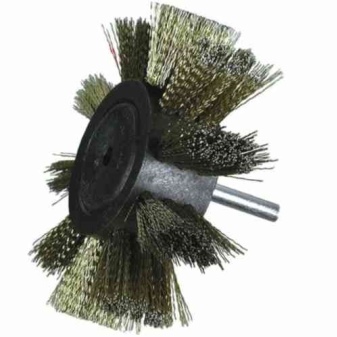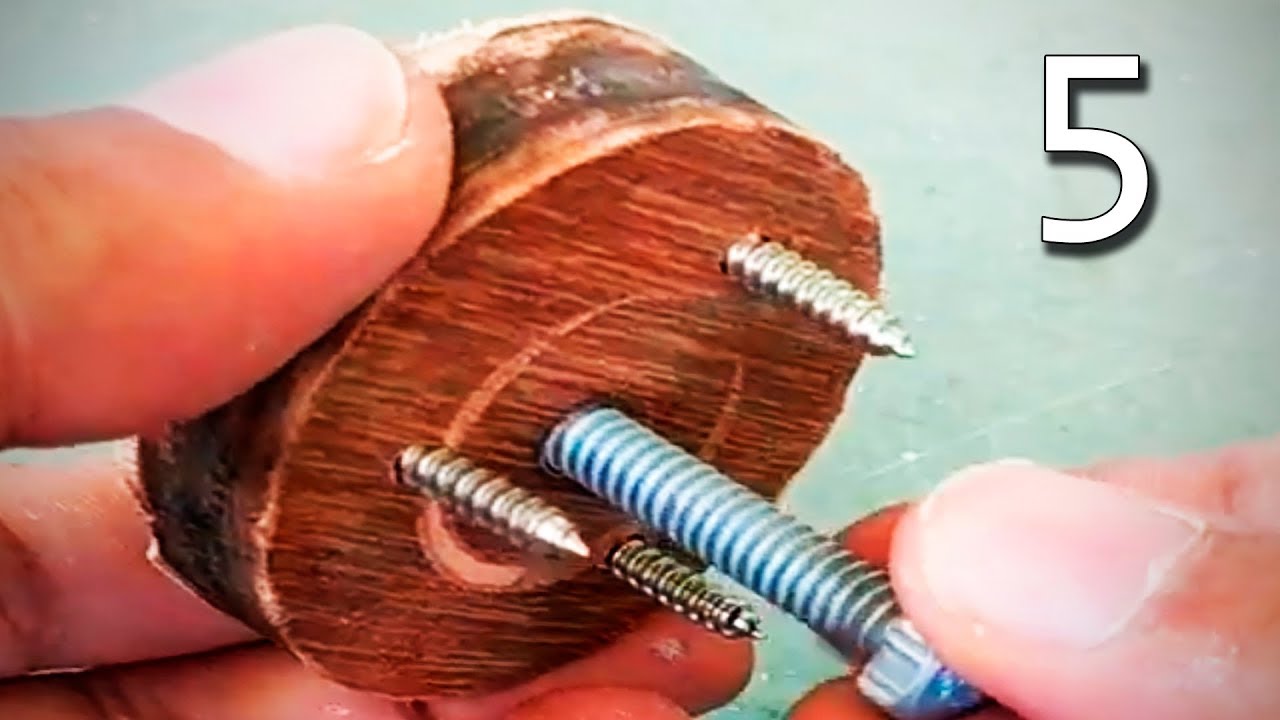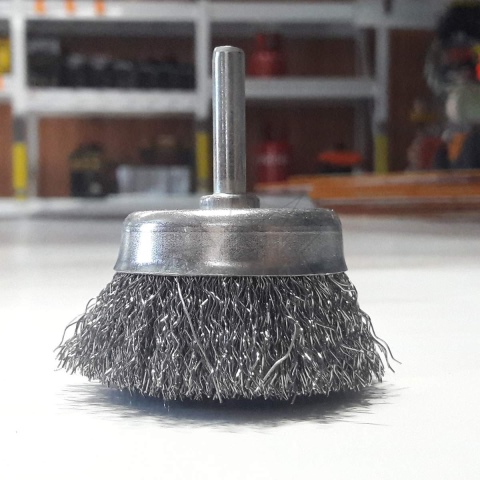The device and purpose of the attachments
Almost any nozzle is a rod that is inserted into the holder (chuck) of the drill. On the other side of the rod is the actual nozzle. If the nozzle is made for other tools (for example, a grinder), when the rod does not fit, use adapters, as well as adapters
It is important to carefully fix such a replaceable device as a nozzle in the chuck.


Brush heads have one or more purposes:
- grinding of various types of materials (metal, wood, concrete);
- cleaning metal products from scale and rust (brushed);


- removing old paint;
- polishing of various types of surfaces (wood, glass, metal, varnish coatings);
- removal of gumboils on concrete at the time of leveling the floor.


Photo of brushes for metal for grinders and drills
































We also recommend viewing:
- What are aluminum rivets
- Best screwdriver bits
- Which polyurethane foam is better
- Choosing a blade for a hacksaw for metal
- Overview of drills and drills for rock drill
- Overview of diamond core bits for concrete
- The best concrete drills for drills and hammer drills
- How to choose a good diamond blade for concrete
- Which abrasive disc is better to choose
- Wood milling cutters for hand router
- How to find the right grinding wheel
- Which drill chuck is better
- Choosing good wood drills
- Types and sizes of staples for the stapler
- Why do you need a unipack
- What and how to choose a line for a trimmer
- Which drills for metal are better
- Which chainsaw oil to choose
- Cut-off wheels for grinders
- Metal pipe clamps
- How to choose a galvanized bucket
- How to choose a circular saw blade
- Types of jigsaw files
- Varieties of petal circles
- What is tow
- Nylon ties
- Types and application of electrical tape
- Choosing a light plastic bucket
- How to choose safety glasses
- Why do you need masking tape
Help the site, share on social networks 
Features of use depending on the rigidity
Depending on the function performed, the attachments can be hard or soft. As a rule, soft materials are used for polishing, finishing cleaning of soft material. It can be foam rubber of different thickness, felt, microfiber for jewelry or sisal. A sisal brush is like a twisted rope attached to a cylinder or disc. Natural coarse fiber from palm leaves completes well the processing of wood after brushing (aging). Felt is used to polish paint and varnish coatings or bring metal to a shine.


Synthetic nylon is used in intermediate surface treatment
It is important not to allow overheating during operation - polymers begin to melt rather quickly
Iron brushes are the toughest. And the thicker the wire, the more difficult the job will be done. The main section of the wire is approximately 5 millimeters. Corrugated and soft brass are used for finishing. Thicker than 5 millimeters - for initial processing.


Reliable firms

Figure 10. Firms
When choosing a metal brush for a drill, you should pay attention only to the products of well-known, proven brands. Otherwise, there is a high probability of buying a low-quality product, which will not allow the necessary work to be carried out.
Now on the market there are enough models of cord brushes for drills from different companies. There are both Russian and foreign brands. Usually companies do not focus on any specific brushes, but create the entire necessary set.Among the most reliable manufacturers, brands stand out:
- STAYER MASTER;
- Anchor;
- KROFT;
- FIT;
- MATRIX.
All these companies produce metal brushes of different hardness to carry out all possible work. Each has features that seem to be the manufacturer's chips, which you quickly get used to.
Summary

Article Name
Drill brush
Description
How to choose a drill. How to make a wire brush for a drill
Author
Publisher Name
Construction tool wikipedia
Publisher Logo

Varieties of stiffness

Figure 8. Rigidity
The rigidity of the nozzle largely depends not only on the thickness of the wire, but also on the type of pile. There are the following types:
- Smooth, smooth wire. The simplest type, which does not differ in durability and efficiency.
- Twisted wire. Strength is significantly increased due to the fact that each hair is curled.
- Corrugated. Most advanced, providing good surface pressure with relatively low vibration.
A thin wire is much easier on a metal surface. Found wide application in the manufacture of corsets. Thick varieties will scratch the surface and clean it efficiently, even from stubborn dirt. Each tip needs to be applied at the right time. If there is no dirt on the parts and only polishing is needed, then the use of hard brushes is simply impractical.
Why spark drill electric motor brushes
In any electric motor there are graphite (carbon) brushes. With constant friction, the mechanism is worn out, as a result of which the graphite dust settles on the collector. This is where sparking begins. As a result of abrasion, brush wear occurs - this is the second reason. If this happened to your drill, then it will slow down or the electric motor may not turn on. The third reason is the incorrect installation of the brushes in the brush assembly.


After disassembling the drill and visually checking the grooves of the brush assembly, you need to make sure that the device can still be used. Sparking is also possible when the stator fails, collector contacts are closed due to graphite dust, and contacts are contaminated with carbon deposits. In some cases, cleaning the brush assembly will help, and in others, replacing the brushes or brush springs. It will not be difficult to replace the worn part, and the drill will serve in the same mode.


How to choose a brush

Figure 9. Choice of tip
Before choosing a brush, it is important to formulate the necessary requirements for the nozzle. For large-scale construction or repair work, it is logical to purchase a whole set of brushes for different degrees of processing
This set is suitable for sanding walls, floors, cleaning surfaces from paint and much more.
The set will allow you not to fear that at the right time the necessary brush will not be at hand. A wide range of possibilities opens up immediately for repair work
It is important to consider whether the drill supports purchased accessories. If not, you may have to buy additional adapters.
You should choose quality adapters from well-known manufacturers. They will be responsible for the reliability of the attachment of the nozzle to the drill. This is an important parameter given that there is a lot of pressure on the brush when working.
Additionally, it is worth considering the revolutions for which the nozzle is designed. If they do not match the speed of the drill, then the work will not bring any results. There is a high probability of quick wear of the nozzle. The metal brushes are designed to work at high speeds. Do not use them on low speed drills.
Features of the nozzle
The brush is a rod for installation in a drill with a working body attached to it. Sometimes the rod may not fit the drill. This is especially true for grinder attachments and other tools. Then the logical solution would be to use adapters and adapters. Only a secure attachment of the nozzle in the drill will allow you to be confident in high-quality work.
Brushes are made from different materials. Steel wire is commonly used. It can be used in the form of a corrugation or a bundle. Each version has its own characteristics and is suitable for different jobs. This will be described in more detail below.
To work with stainless steel or non-ferrous metals, stainless steel wire is used. Brass is suitable for processing relatively soft rocks. It can be non-ferrous metal, plastic or wood.
Sometimes an abrasive can be used as a base. It is applied for fine surface treatment, grinding and polishing.
Functions

Radial brush for angle grinders with twisted steel wire bristles. Photo Practice
Cord brushes are used for processing wood, metal, concrete, stone, plastic products, as well as surfaces coated with paint and varnish. With the help of brushes, the following operations are performed:
- cleaning from old paint and varnish, corrosive deposits, slag and scale, tarnishing colors;
- cleaning products before welding;
- grinding and polishing;
- removal of unnecessary part of the weld metal from welded seams;
- brushing, texturing and roughing of wood;
- alignment of roughness;
- deburring;
- grinding sharp corners;
- roughing and finishing.
Often, cord brushes are used as an alternative to abrasive wheels.
Varieties of brushes
Depending on the purpose and type of surface treatment, brushes are divided into several types.
- Polishing.
- Grinding.


- For removing dirt from flat surfaces or hard-to-reach places.
- For brushing wood.
- Machining welds.


According to the material used, they are divided into the following types:
- metal;
- foam rubber;


- abrasive polymer nylon;
- abrasive lamellar emery;
- felt.


At the same time, for the manufacture of brushes, the following is used:
- steel wire, if you want to process a metal surface;
- steel wire in the form of a corrugation, having different rigidity, determined by the diameter of the wire;


- braided steel - has increased hardness and self-sharpening effect;
- stainless steel for working with stainless steel and aluminum;
- brass wire for cleaning and grinding soft metals (bronze, copper), wood, texturing plastic;
- polymer abrasive - abrasive with a bristle based, for example, silicon carbide, used for finishing, roughing, texturing, rounding of edges.


Work safely with your drill
Sometimes the implementation of simple rules saves not only health, but also life. Therefore, when using a drill with an attachment, you must:
- make sure that the brush is selected correctly for the selected type of work;
- securely fix the rod into the drill chuck;
- hold the drill with both hands;


- at the beginning of work, test the brush on an insignificant surface so as not to damage it;
- regulate pressure;
- until the drill has completely stopped, do not turn on the reverse mode;
- after turning off the drill, do not touch the brush and the rod until it cools completely, in order to avoid burns;
- be sure to use personal protective equipment: gloves, goggles or mask, respirator when grinding, cleaning, polishing.
For information on how to choose the right brushes for a drill, see the next video.
Nozzle functions: paint stripping, sanding, cleaning and more
Drill bits serve many functions. With their help, it is possible to perform descaling from the surface. This procedure is called brushing. Therefore, nozzles are also often called brushes or brushes.
In addition, the devices are used for:
- brushing wood;
- removing paint, primer, slag, tarnishing colors, rust and cleaning products from other contaminants;
- grinding wood and metal surfaces;

Shank brushes. Lessmann Photos
- polishing of metal, wood, glass, paint and varnish products;
- grouting.
This list is incomplete, it can be listed for a long time. But it is worth noting that corsets are in demand in various areas of production. In some cases, there is a possibility that the performer will not be able to find an alternative to cord brushes.
Processing rigidity
The rigidity of the processing differs from the type of wire structure, hardness and thickness. So, if the wire is thin, then it acts more easily on the metal. Usually it is used in the manufacture of corsets.

If it is necessary to clean a certain plane of debris, then use a nozzle with a stiff bristle. To complete the cleaning, use a nozzle with a lower hardness. This is used so that the brush does not spoil the surface itself, but simply cleans it from the remnants of unnecessary old paint.


Choose the right brush for your grinder and drill. Consider when choosing the speed for the machine. This rule cannot be ignored, because if you put a brush designed for low speed on a machine with high speed, then there will be no result.

And such a brush will quickly deteriorate and become unusable. This also applies to metal brushes. They are designed for high rotational speeds, so don't turn it on at low speeds. So, such a brush will not give the desired result.

You should be very careful about the purchase, because the final result depends on it. You should only purchase brushes from reliable manufacturers so as not to buy a low-quality brush and not waste your money.

Nozzle shapes
No matter how different the brushes are, they are all round. In terms of shape, drill brushes have a fairly wide range.
- Radial, flat - for grinding metal, cleaning in hard-to-reach places, for example, in pipes.
- Plates really resemble a plate in shape. Available in plastic or rubber with bonded sandpaper for cleaning, polishing or sanding. To be able to hold the drill strictly above the surface to be treated, such a nozzle is attached to a pin with an adjustable fastening angle.


- Cylindrical (brushes) - used for narrow pipes in small to medium-sized areas. In addition, these conical tips are used for grinding or polishing jewelry or other precision work.
- Disc (circular, oval) - flat metal nozzles for processing large areas during repair or construction. Twisted steel filaments are capable of cleaning welded joints (seams and joints), thoroughly polishing surfaces. The bristles are directed from the center to the edge of the disc.
- Cup (brush) - they are distinguished by the presence of a container of different diameters, into which a very rigid steel wire is pressed - it can be of different lengths - or nylon pile, filled with molten plastic. Such brushes are used for descaling, removing paint from surfaces, removing concrete fluxes - irregularities, as well as for brushing wood.


- Drum - is a cylinder with attached sandpaper for polishing iron surfaces. And also it can be foam rubber (felt), microfiber for more delicate processing of wood, glass, metal.
- Fan (flap) brushes are a disc with attached sandpaper plates perpendicular to the surface. Such an abrasive nozzle is convenient for cleaning and grinding surfaces of various geometries, since it is capable of changing its own shape when the drill is running.
- Petal are cylinders to which a metal abrasive pile is attached. Used for removing paint, rye, burrs, polishing, cleaning, brushing.
- Conical - are a cross between disc and cup brushes. Designed to remove heavy dirt, paint, scale, burrs.


Features of work

Figure 7.Using the nozzle
All attachments have their own purpose. Improper use can result in damage to the work piece or simply ineffective operation. Soft brushes are used for finishing and polishing the part. They can be useful when cleaning soft materials from dirt. Soft brushes are made of felt, foam or sisal. The latter type is a natural polishing fiber. For the same purposes, felt is used, which perfectly copes with plaque on metals.
It is important to take into account that there is a high risk of melting when using polymer fibers. During operation, the surface can become very hot, and the material is sensitive to temperature increases
For steel brushes, the fundamental parameter will be the thickness of the wire used. Typically, a medium hard wire with a cross section of 5 mm is used. Finishing can be done with brass brushes. But even they, with a large wire thickness, are suitable for rough work.







































